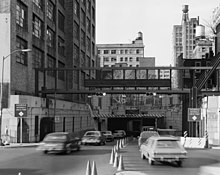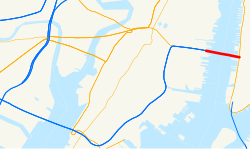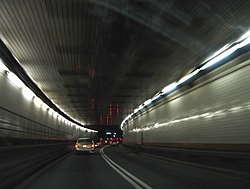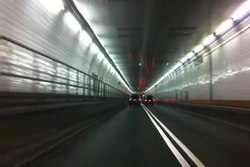ராதே கிருஷ்ணா 13-04-2013

Holland Tunnel
The Clifford Milburn Holland Tunnel (more commonly known as the Holland Tunnel) is a highway tunnel under the Hudson River connecting the island of Manhattan in New York City with Jersey City, New Jersey at Interstate 78 on the mainland of the United States. Unusually for an American public works project, it is not named for a government official, a politician, a local hero, or a person of historical interest, but for its first chief engineer. An integral conduit within the New York Metropolitan Area, the tunnel was originally known as the Hudson River Vehicular Tunnel or the Canal Street Tunnel; it was the first of two automobile tunnels built under the river, the other being the Lincoln Tunnel.
| Holland Tunnel | |
|---|---|
 Holland Tunnel Entrance, Manhattan | |
| Official name | Clifford Milburn Holland Tunnel |
| Carries | 4 lanes of |
| Crosses | Hudson River |
| Locale | Connecting Jersey City, New Jerseyto Lower Manhattan in New York City |
| Maintained by | Port Authority of New York and New Jersey |
| Total length | 8,558 feet (2,608.5 m) (westbound) 8,371 feet (2,551.5 m) (eastbound) |
| Vertical clearance | 12.5 feet (3.8 m) |
| Opened | November 13, 1927 |
| Toll | (eastbound only) As of 2 December 2012; Cars $13 for cash, $10.25 for Peak (E-ZPass), $8.25 for off-peak (E-ZPass) |
| Daily traffic | 93,356 (2010)[1] |
 | |
Description
Begun in 1920 and completed in 1927, the tunnel is named after Clifford Milburn Holland (1883–1924), Chief Engineer on the project, who died before it was completed. Tunnel designer Ole Singstad finished Holland's work. The tunnel is one of the earliest examples of a mechanically ventilated design. 84 fans, in four ventilation buildings, create a floor to ceiling air flow across the roadway at regular intervals, via systems of ducts beneath and above the roadway. The fans can completely change the air inside the tunnel every 90 seconds. A forced ventilation system is essential because of the poisonous carbon monoxide component of automobile exhaust, which constituted a far greater percentage of exhaust gasses before catalytic converters became prevalent.
The tunnel consists of a pair of tubes, each providing two lanes in a 20-foot (6 m) roadway width and 12.5 feet (3.8 m) of headroom. The north tube is 8,558 feet (2,608 m) from end to end, while the south tube is slightly shorter at 8,371 feet (2,551 m). Both tubes are situated in the bedrock beneath the river, with the lowest point of the roadway approximately 93 feet (28 m) below mean high water.
The amount of traffic at the Holland Tunnel has remained steady despite tight restrictions on eastbound traffic in response to the September 11 attacks, including a ban on commercial traffic entering New York City put in place after an August 2004 threat. The tunnel was used by 34,698,000 vehicles in 2007,[5] according to the Port Authority of New York and New Jersey, the bi-state government agency that owns and operates the Holland Tunnel. That is slightly less than the 34,729,385 vehicles seen in 2006, but up from the 33,964,000 vehicles in 2005.
The tunnel was designated a National Historic Civil and Mechanical Engineering Landmark in 1982[8] and a National Historic Landmark in 1993.
Holland Tunnel
| |
 | |
| Location: | Jersey City, NJ and New York, NY |
|---|---|
| Coordinates: | 40°43′39″N 74°1′17″WCoordinates: 40°43′39″N 74°1′17″W |
| Built: | 1920 |
| Architect: | Clifford Holland |
| Governing body: | Port Authority of New York and New Jersey |
| NRHP Reference#: | 93001619 |
| Significant dates | |
| Added to NRHP: | November 4, 1993[2] |
| Designated NHL: | November 4, 1993 |
Boyle Plaza
The approach to the Holland Tunnel in Jersey City begins where the Lower Level of NJ 139 and the Newark Bay Extension meet. On May 6, 1936, the section of what becameNJ 139/I-78 between Jersey Avenue and Marin Boulevard was named in memory of John F. Boyle, the former interstate tunnel commissioner.[12] Boyle Plaza is the only segment of I-78 and NJ 139 that has stoplights, as it runs concurrent with 12th Street (the eastbound lanes) and 14th Street (the westbound lanes) in Jersey City.
As of December 2, 2012, the cash tolls going from New Jersey to New York are $13 for cars and $12 for motorcycles; there is no toll for passenger vehicles going from New York to New Jersey. E-ZPass users are charged $8.25 for cars and $7.25 for motorcycles during off-peak hours (outside of 6–10 a.m. and 4–8 p.m. on the weekdays; and outside of 11 a.m.–9 p.m. on the weekends) and $10.25 for cars and $9.25 for motorcycles during peak hours (6–10 a.m. and 4–8 p.m. on the weekdays; and 11 a.m.–9 p.m. on the weekends).

History
Passage across the lower Hudson River was only by ferry for centuries. The first tunnels to be bored below the Hudson River were the Hudson & Manhattan Railroad's uptown and downtown tunnels, constructed in the first decade of the 20th century to link the major railroad terminals in New Jersey with Manhattan Island (they currently run PATH trains). The Pennsylvania Railroad's twin tunnels, constructed to serve the newPennsylvania Station, soon followed. Once tunneling had been shown to be feasible, increasing automobile traffic led to interest in a roadway crossing the river as well.
The concept for what would become the Holland Tunnel was developed in 1906 by a joint commission between New York and New Jersey. The commission initially considered building a bridge for cost reasons, but this plan was abandoned in favor of a tunnel in 1913 when it was determined that the cost of land for accessways to a suitably raised bridge would be prohibitive as a height of 200 ft (60 m) was considered the minimum necessary to avoid interfering with shipping.[15]
Over the next several years, a number of design proposals were evaluated for the new tunnel. The first two called for a single tube containing two levels of traffic. One, authored by engineer George Goethals specified that traffic on each level would travel in a different direction. The other, by the firm Jacobs and Davies, called for a slightly different tube diameter, with an "express" level and a level for slower traffic. Both designs were eventually passed over in favor of a new type of design proposed by engineer Clifford Milburn Holland, in which two separate tubes would each contain two lanes both going in the same direction. Holland's proposal was adopted, and he was named Chief Engineer of the project.[16]Promotional materials compared the diameter and capacity of the proposed tunnel with the smaller-diameter railroad tunnels.
In 1920, the New Jersey Interstate Bridge and Tunnel Commission and the New York State Bridge and Tunnel Commission appropriated funds for what was then referred to as the "Hudson River Vehicular Tunnel Project". Construction began on March 31, 1922, with a crew of workers starting digging at the corner of Canal Street and West Street.[17] On October 27, 1924, the day before the two halves of the tunnel were scheduled to be linked, 41-year-old Holland died of a heart attack in a sanatorium in Battle Creek, Michigan, attributed by individuals cited in The New York Timesto the stress he endured overseeing the tunnel's construction. "Holing through" ceremonies scheduled for that day, in which President Calvin Coolidge would have remotely set off an explosion to connect the two sides of the tunnel, were canceled out of respect for Holland's death.[18]
The project was renamed the Holland Tunnel in memory of its first chief engineer by the New York State Bridge and Tunnel Commission and the New Jersey Interstate Bridge and Tunnel Commission on November 12, 1924.[8] Holland was succeeded by Milton H. Freeman, who died of pneumonia in March 1925, after several months heading the job.[19] After Freeman's death, the position was occupied by Ole Singstad, who oversaw the completion of the tunnel and designed its pioneering ventilation system.
Lincoln Tunnel
The Lincoln Tunnel is a 1.5-mile (2.4 km) long tunnel under the Hudson River, connecting Weehawken, New Jersey and Manhattan, New York City. An integral conduit within the New York Metropolitan Area, it was designed by Ole Singstad and named after U.S. President Abraham Lincoln. It is one of two automobile tunnels built under the river, the other being the Holland Tunnel.
 | |
| Lincoln Tunnel, New Jersey entrance | |
| Overview | |
|---|---|
| Coordinates | 40.7625°N 74.0111°WCoordinates: 40.7625°N 74.0111°W |
| Status | active |
| Route | |
| Operation | |
| Opened | December 22, 1937 (Center tube) February 1, 1945(North tube) May 25, 1957(South tube) |
| Operator | Port Authority of New York and New Jersey |
| Traffic | vehicle |
| Character | public |
| Toll | (eastbound only) As of December 2, 2012; Cars $13 for cash, $10.25 for Peak (E-ZPass), $8.25 for off-peak (E-ZPass) |
| Vehicles per day | 108,655 (2011)[1] |
| Technical | |
| Construction | March 1934 – December 1937 (center) 1937–1938, 1941–1945 (north) ?–1958 (south) |
| Length | 7,482 ft (2,281 m) (north) 8,216 ft (2,504 m) (center) 8,006 ft (2,440 m) (south)[2] |
| Number of lanes | 6 |
| Operating speed | 35 miles per hour (56 km/h)[3] |
| Lowest elevation | −97 feet (−30 m)[2] |
| Tunnel clearance | 13 feet (4.0 m)[2] |
| Width | 21.5 feet (6.6 m)[2] |
History
The tunnel was originally to be named the Midtown Vehicular Tunnel, but the planners eventually decided that the new tunnel deserved a name that was of similar importance to that of the George Washington Bridge, and named it after Abraham Lincoln.[4]
Designed by Ole Singstad, the tunnel was funded by the New Deal's Public Works Administration. Construction began on the first tube in March 1934.[5] It opened to traffic on December 22, 1937, charging $0.50 per passenger car, equal to $8.58 today. The cost of construction was $85,000,000, equal to $1,458,743,781 today.[6]
The original design called for two tubes. Work on the second was halted in 1938 but resumed in 1941. Due to war material shortages of metal, completion was delayed for two years. It opened on February 1, 1945 at a cost of $80 million, with Michael Catan, brother of Omero Catan (known as Mr. First, attending over 526 opening day events), selected to be the first to lead the public through the tube.[7]
A third tube was proposed by the Port Authority of New York and New Jersey due to increased traffic demand but initially opposed by the City of New York, which was trying to get the Port Authority to help pay for the road improvements that the City would need to handle the additional traffic. Eventually, a compromise was worked out, and the third tube opened on May 25, 1957 to the south of the original two tunnels.[8] Although the three portals are side by side in New Jersey, in New York City the north tube portal is one block west of the other two, which emerge side by side at Tenth Avenue between 38th & 39th Streets.
In 2012, which marked the 75th anniversary of the Lincoln Tunnel, and 85th anniversary of the Holland Tunnel in nearby Jersey City, the Hoboken Historical Museum held an exhibit in its Main Gallery called Driving Under the Hudson: The History of the Holland and Lincoln Tunnels, which explores the two tunnels' histories, and how they affected the region. Rutgers University professor Angus Gillespie, who wrote the 2011 book,Crossing Under the Hudson: The Story of The Holland and Lincoln Tunnels, served as a consultant for the exhibit's design.
Operations
Tubes
| Name | Opening year | Length | Comments |
|---|---|---|---|
| Lincoln Tunnel | south tube: 1957 center tube: 1937 north tube: 1945 | south tube: 2,440 m (8,006 ft) center tube: 2,504 m (8,216 ft) north tube: 2,281 m (7,482 ft) | NJ 495/I-495 |





கருத்துகள் இல்லை:
கருத்துரையிடுக